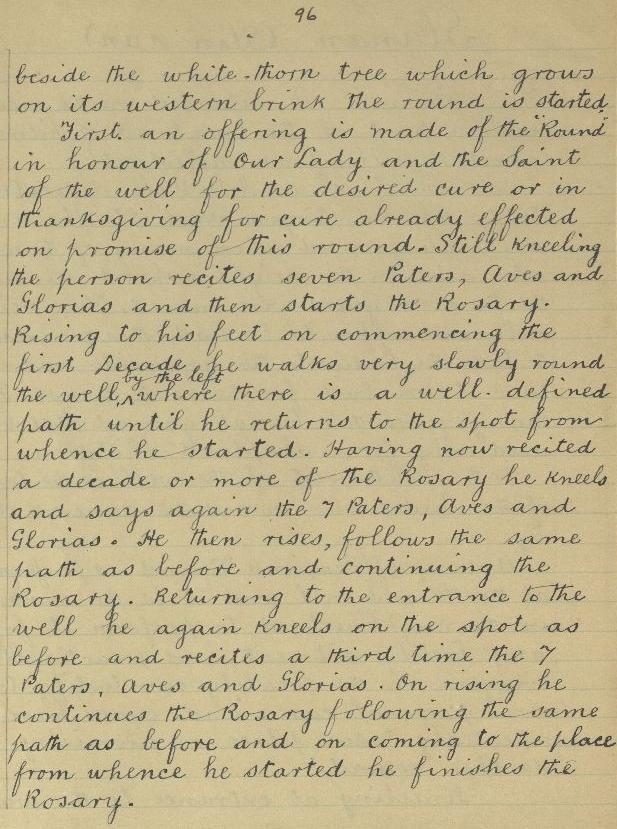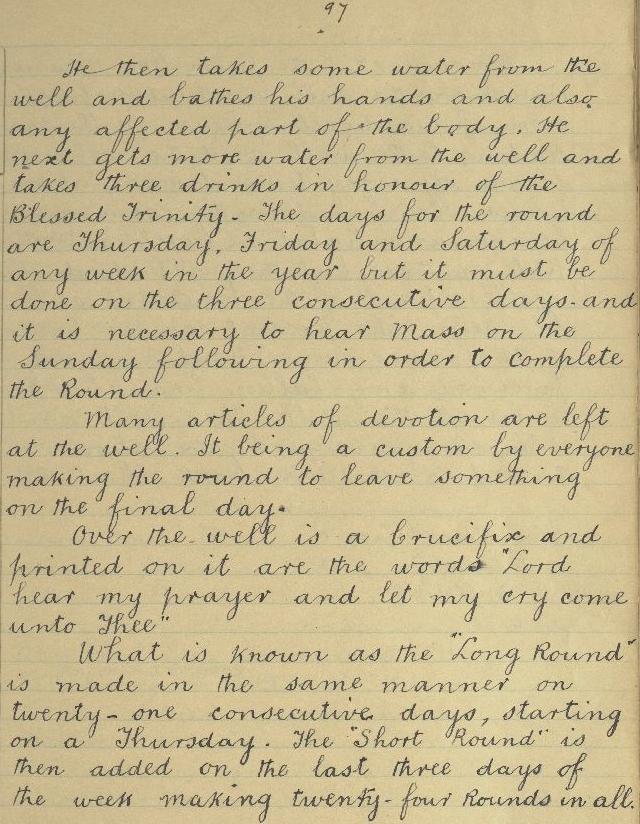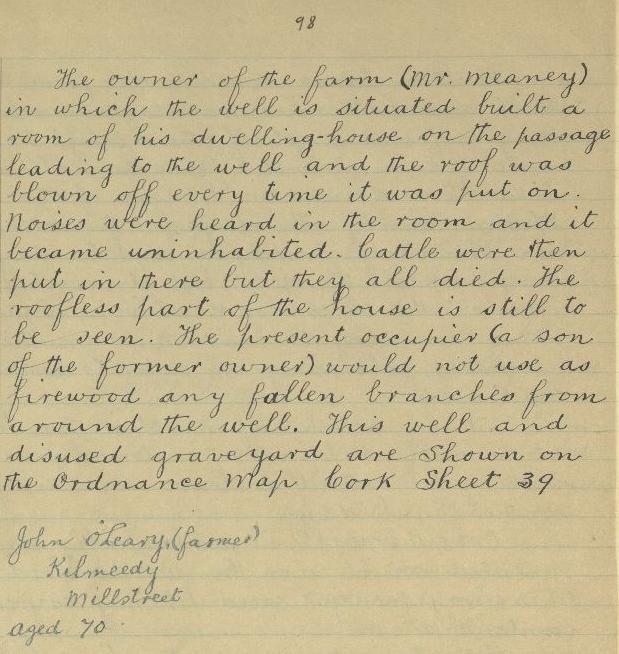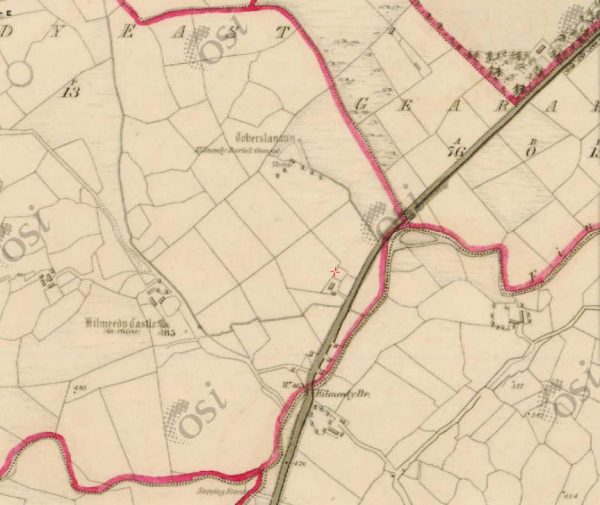

 Recorded as part of the Schools Collection – folklore compiled by schoolchildren in Ireland in the 1930s.
Recorded as part of the Schools Collection – folklore compiled by schoolchildren in Ireland in the 1930s.
School: Cloch Bhuaile
Location: Cloghboola More, Co. Cork
Teacher: Seán Ó Dochartaigh
Stories taken from November 1937 to December 1938
Link: http://www.duchas.ie/en/cbes/4921689/4890122
==============
Slanan Well was a place of great veneration right up to the 1980’s. The old people had great faith in it’s healing powers and often told stories of great favours granted there. It is situated in the fields about two hundred yards to the right of the main road as you approach Kilmeedy bridge. It is just one of a number of very interesting features which make up this historical location. Just beside it stands the tomb in which are buried the Leaders of the Mount Leader estate, which is encased in a stone built protective outer wall with iron railing on top. Standing stones in various formations mark the burial places of others but as these stones bear no names or markings it is not known who they were. There is also a square or rectangular space said to be the site of a church oratory. St Ide was the saint connected with the place and the local town land of Kilmeedy got it’s name from her church. Legend has it that she was a sister of St Lateran of Cullen, St Abbey of Ballyvourney .
– from Macroom Road: Spots of Beauty and Historical Interest – by Eily Buckley
==============
Earlier Parish of Kilmeedy.
The earlier church at Kilmeedy was located close to Tobar
Slanan which is about 400 metres to the north of the castle, two fields
in from the Millstreet-Macroom road. It is featured in the 1842
Ordinance Survey map as a sub circular area, enclosed by a field
fence. It includes a holy well surrounded by a wall of loose stones, a
disused graveyard defined by numerous un-inscribed standing stones
or grave markers, a tomb enclosed by a railing marking the burial plot
of the Leader family (Henry Leader, who died aged 62, on November
9th 1809, and his two children were the last people buried there) and
the foundational remains of a church wall of about 10 metres, aligned
in an east west direction. In the ‘Archaeological Inventory of Mid-
Cork’, (N9347), B. O’Donoghue is quoted as suggesting that this was
the church dedicated to St.Ita (Cill mo Ide).
If this is correct, it marks the site of the earliest known church
in the present parish of Millstreet, which is referred in Papal letters as
Drishane alias Kylmide. Its existence preceded the building of the
nearby castle, built by the McCarthys circa 1435. It is unlikely that
this foundation dates back to the time of St Ita, who died in 570 and
whose Feast Day is January 15th. Her convent was at Cluain Credail
(know known as Killeedy), County Limerick, but there is no mention
of her evangelising in the Millstreet area in the medieval account of
her life. There are, however, a number of churches dedicated to her,
particularly in the counties of Waterford, Cork, Limerick and Kerry.
– from the Origins and Development of the Parish of Millstreet – by Fr. Sean Turker (2008)
 Slánan Well (from around 2008), – used as the front cover of The Origins and Development of the Parish of Millstreet – by Fr. Sean Turker (2008)
Slánan Well (from around 2008), – used as the front cover of The Origins and Development of the Parish of Millstreet – by Fr. Sean Turker (2008)
==============
 The 1842 Ordinance Survey Map of Kilmeedy, showing Slánan Well (Toberslanaun, Kilmeedy Burial Ground), Kilmeedy Castle, Kilmeedy Bridge etc. The red lines are the townland boundaries. [ref]
The 1842 Ordinance Survey Map of Kilmeedy, showing Slánan Well (Toberslanaun, Kilmeedy Burial Ground), Kilmeedy Castle, Kilmeedy Bridge etc. The red lines are the townland boundaries. [ref]
==============
 The view of Slánan Well from the roadside (it’s in the bushes at the end of the field, behind the big tree) [ref]
The view of Slánan Well from the roadside (it’s in the bushes at the end of the field, behind the big tree) [ref]
==============
The word “Slánan” in this context means “healing”.
There is another Slánan well at Dooniskey, near Lissarda, and a Slánan stream at Gougane Barra.
==============
The local football team from Cloghoula, took their name Slanan Rovers from the holy well. [see our articles on Slanan Rovers]
McCarthy’s who are the current owners of the land, keep greyhounds, and they use Slanan as the fore name for their dogs.
==============
The Meanys of Kilmeedy East who owned the land on in the 1911 Census [ref]
John Leary of Kilmeedy West (the author of the account on Slánan Well) is noted in the 1911 census – he died on 26th October 1951 aged 76.
==============
Below is the transcription of the background of Slánan Well at the top of this article:
Slánan Holy Well (Slán ann)
The Slánan is situated in the most eastern part of the townland of Kilmeedy about 1½ miles from Millstreet.
It consists of a Holy Well dedicated to the Blessed Virgin and St.Ita and a burial ground where many of those who died in the neighbourhood during the famine years wereburied. There being only one coffin to be had, this was used to take the bodies to the graveside and was then taken back for the next corpse. For many years this burial ground had been used only for unbaptised children.
To the south-west of the well is the tomb of the Leader who owned the demese close by.
A very efficacious “Round” is performed at this blessed well and it is the custom in the neighbourhood to perform it for any bodily ailment, and practically everyone in the locality can testify to some personal cure, and cures have repeatedly taken place on promising to do this round. Kneeling at entrance to the well beside the white-thorn tree which grows on its western brink the round is started.
First an offering is made of the Round in honour of Our Lady, and the saint of the well for the desired cure or in thanksgiving for cure already effected on promise of this round. Still kneeling the person recites seven Paters, Aves and Glorias and then starts the Rosary.
Rising to his feet on commencing the first decade he walks very slowly round the well by the left where there is a well defined path until he returns to the spot from whence he started. Having now recited a decade or more of the Rosary he kneels and says again the 7 Paters, Aves and Glorias. He then rises follows the same path as before and continuing the Rosary. Returning to the entrance to the well he again kneels on the spot as before and recites a third time the 7 paters, Aves and Glorias. On rising he continues the Rosary following the same path as before and on coming to the place from whence he started he finishes the Rosary.
He then takes some water from the well and bathes his hands and also any aggected part of the body. He next gets more water from the well and takes three drinks in honour of the Blessed Trinity. The days for the round are Thursday, Friday and Saturday of any week in the year but it must be done on the three consecutive days and it is necessary to hear mass on the Sunday following in order to complete the Round.
Many articles of devotion are left at the well. It being a custom by everyone making the round to leave something on the final day.
Over the well is a Crucifix and printed on it are the words “Lord hear my prager and let my cry come unto Thee”.
What is known as the “Long Round” is made in the same manner on twenty one consecutive days, starting on a Thursday. The “Short Round” is then added on the last three days of the week making twenty four Rounds in all.
The owner of the darm (Mr.Meaney) in which the well is situated built a room of his dwelling house on the passage leading to the well and the roof was blown off every time it was put on.
Noises were heard in the room and it became uninhabited. Cattle were then put in there but they all died. The roofless part of the house is still to be seen. THe present occupier (a son of the former owner) would not use as firewood any fallen branches from around the well. This well and disused gfraveyard are shown on the Ordinance Map Cork Sheet 39.
John O’Leary (farmer), Kilmeedy, Millstreet. Aged 70.
Recorded as part of the Schools Collection – folklore compiled by schoolchildren in Ireland in the 1930s.
School: Cloch Bhuaile
Location: Cloghboola More, Co. Cork
Teacher: Seán Ó Dochartaigh
Link: http://www.duchas.ie/en/cbes/4921689/4890122
==========
With thanks to Kevin for reminding us of these notes on Slánan Well


My Name is Eugene (Gene) Barrett and I know
the man that made the cross. He was Jack Healy,
he lived across from the Grotto in Liscahane.
He was a stone mason and he had a great faith
and devotion to the well. I was reared by Jack and
Moll Healy after my Mother Hannah Barrett,
Aubane died in 1943.
Jack got permission from the Owner of the land
at the time. Jack was a very shy, private man so
we took the cross to the Slánan on a donkey and
cart at dawn so no one would see him put it up.
It was lovely to read this article and reminisce
about times gone by.